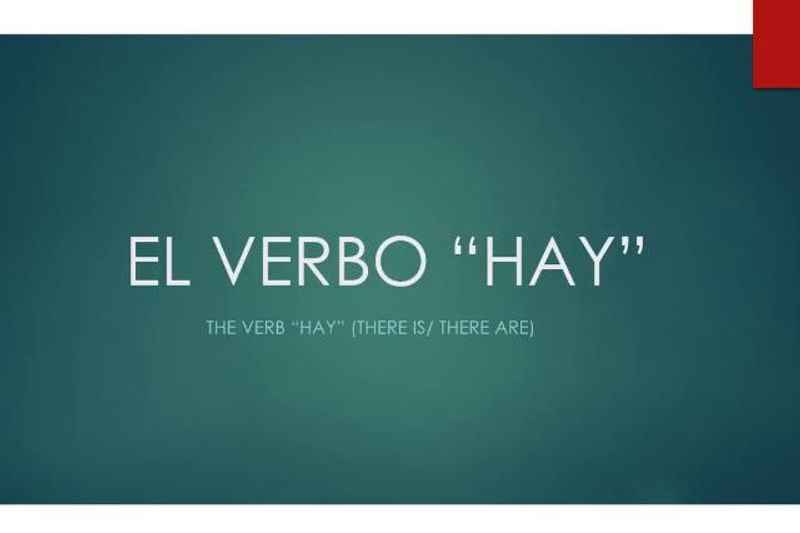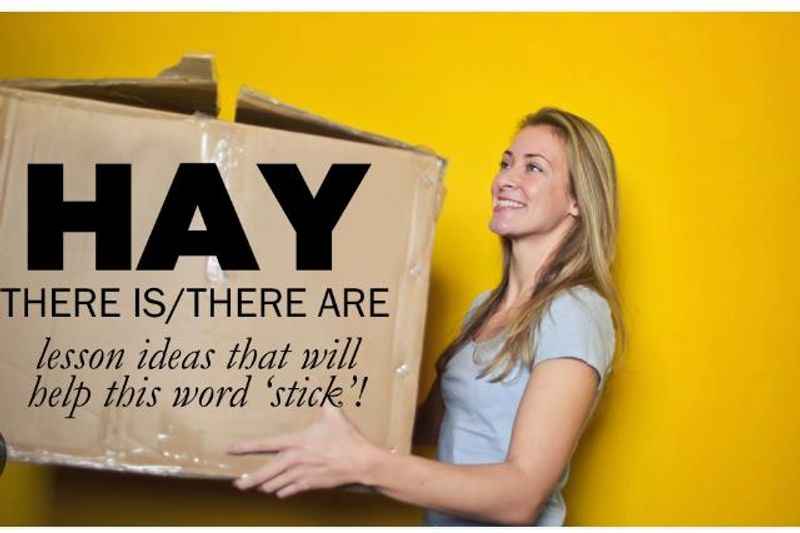How to Say 'There is' and 'There are' in Spanish: A Guide

One of the first things you need to grasp when learning a new language is how to say there is or there are. It will enable you to express yourself in a variety of situations and even ask important questions.
In Spanish, the translation for this is hay.
Like most languages, there are several ways to use 'there is' in Spanish in everyday conversation.
In this post, we will go over all of the different uses for hay and teach you how to say there is and there are in Spanish correctly. All whilst learning some grammar along the way!
'There is' in Spanish: How to Use Hay

In Spanish, hay means "there is" or "there are." It is derived from the verb haber, which originally meant "to have" in Old Spanish. Over time, haber evolved into an auxiliary verb used to form compound tenses and to express existence, surprise, and other meanings.
The word hay can be used in several ways, all with different meanings.
Below are some instances in which you may find yourself using the verb.
- To say there is or there are
- To express existence
- To show surprise, disbelief, or excitement
- As an interjection
- In idiomatic expressions
Examples of sentences along with the English meaning include:
🇪🇸 Hay un libro en la mesa. There is a book on the table
🇪🇸 ¿Hay leche en su casa? Is there milk in your house?
🇪🇸 No hay nadie en la casa There is nobody in the house
🇪🇸 ¡Hay, qué hermoso! Wow, how beautiful!
🇪🇸 No hay mal que por bien no venga Every cloud has a silver lining
🇪🇸 ¡Mira, hay un arcoíris! Look, there's a rainbow!
Notice above that in order to say 'there is not' in Spanish, you simply add a no in front of hay in order to make it negative.
'There is' and 'There are' in the Spanish Language: What's the Difference?

Unlike with a lot of languages, such as English, the word hay doesn't change when expressing 'there is' or 'there are'.
See below for some examples of the use of hay in the Spanish language.
🇪🇸 Hay una playa en mi cuidad 🇺🇸 There is a beach in my city
🇪🇸 Hay unos bares y restaurantes en mi barrio 🇺🇸 There are some bars and restaurants in my neighborhood
As you can see, hay doesn't change when expressing 'there is' or 'there are' in Spanish. This remains the same for both plural and singular sentences.
How to Pronounce Hay in Spanish
The word hay is one of the most common Spanish words, yet learning the pronunciation can be a bit ambiguous.
The letter "h" is never pronounced in Spanish. When you hear a harsh 'h' sound in Spanish, it is actually a 'j' that you can hear.
When you see the word hay written down, you should pronounce it as though there is no 'h' to precede the word.
Perfect Pronunciation
To achieve the most accurate pronunciation of hay, remember it is similar to "eye" in English.
Think of the game "I spy with my little eye," which we use to spot something there is in the room.
How to Use the Phrase Hay Que

In Spanish, hay que means "have to".
For example, you might say:
🇪🇸 Hay que ir al supermercado 🇺🇸 We need to go to the supermarket
Below are some more examples of hay que in spanish sentences:
🇪🇸 Hay que ir al mercado 🇺🇸 You have to go to the market
🇪🇸 Hay que comprar un nuevo libro 🇺🇸 We need to buy a new book
🇪🇸 ¿Qué hay que hacer? 🇺🇸 What needs to be done?
🇪🇸 Hay que lavar la ropa 🇺🇸 The laundry needs to be done
Hay Que and Tener Que
While learning the use of hay que, we should also look at tener que (+ infinitive).
The verb tener expresses more obligation or 'having' to do something, whereas the use of hay que is used more generally. For example;
🇪🇸 Tengo que ir al supermercado porque no hay nada en la casa 🇺🇸 I have to go to the supermarket because there is nothing at home
In this sentence, going to the supermarket is not something the speaker wants to do, but rather something they have to do because there is not enough food at home.
Whereas the use of hay que is a lot more casual and used more frequently. For example:
🇪🇸 Hay que caminar un poco más para llegar a la playa 🇺🇸 We have to walk a bit further to get to the beach
Here, it is necessary to walk a bit further to get to the beach, but it is not an obligation. The phrase hay que is used very frequently in Spanish and can be translated to mean 'one must,' or, 'it is necessary...'
'There is' in Spanish: Other Spanish Phrases That Use Hay
Now that you're getting more familiar with when and when not to use hay, below is a list of some useful phrases for you to practice and their English translation.
Go ahead and practice - remembering the pronunciation!
Examples of Spanish Phrases Using Hay
🇪🇸 Hay una fiesta esta noche 🇺🇸 There is a party tonight
🇪🇸 No hay nadie en casa 🇺🇸 There is nobody home
🇪🇸 ¿Hay alguien aquí que hable inglés? 🇺🇸 Is there anyone here who speaks English?
Examples of Spanish Phrases Using Hay Que
🇪🇸 Hay que estudiar si quieres aprobar el examen 🇺🇸 You have to study if you want to pass the exam
🇪🇸 Hay que + hacer algo 🇺🇸 Something needs to be done
🇪🇸 No hay de que preocuparse 🇺🇸 There's nothing to worry about
Knowing how to use hay and hay que correctly is important when mastering the language.
Therefore, it's important to practice them with fixed phrases like the above in the right context.
Traveling to Spain/ Latin America? Here's Some Useful Spanish Vocab

Now that you've got to grips with the different contextual uses and dynamic features of these verbs in Spanish, here are some other key short phrases with the English translation that will come in useful when you start to use the Spanish language in everyday conversation.
🇪🇸 ¿Cómo estás? 🇺🇸 How are you?
🇪🇸 ¿Cómo te llamas? 🇺🇸 What's your name?
🇪🇸 ¿De dónde eres? 🇺🇸 Where are you from?
🇪🇸 ¿Hablas inglés? 🇺🇸 Do you speak English?
🇪🇸 No entiendo 🇺🇸 I don't understand
🇪🇸 Habla más despacio, por favor 🇺🇸 Speak more slowly, please
🇪🇸 ¿Cuánto cuesta? 🇺🇸 How much does it cost?
🇪🇸 ¿Dónde está el baño? 🇺🇸 Where is the bathroom?
🇪🇸 Tengo una pregunta 🇺🇸 I have a question
🇪🇸 ¿Puedes decirme dónde está? 🇺🇸 Can you tell me where it is?
Moving to a Spanish-speaking community can be hard, especially if you don't speak the language and need to interact with the locals.
Remembering the above phrases will help with your day-to-day life as you're starting out in a Spanish-speaking community.
Useful Ways to Learn Spanish Words

Finding strategies that work for you when learning Spanish is important because the language can be difficult to grasp at first. The first step for any beginner would be to start attending Spanish lessons - either in person or online.
However, if a language course on rosetta stone isn't particularly within your price range, or you don't have the time to commit to a course, luckily, due to the existence of the internet - you already have access to a powerful tool readily available to help you begin learning, and it can be found inside your smartphone.
Free and Easy Ways to Start Learning Spanish
- Listening to Spanish audiobooks, preferably educational and centered around learning Spanish. Once you get more comfortable, you can move on to Spanish novels.
- Listening to Spanish music on Spotify.
- Reading Spanish books. This is particularly helpful for grasping grammar and spelling. Feel free to check out our books for Spanish Learners article.
- Watching Spanish TV Programmes and films on Netflix. This is both enjoyable and a great way to explore dynamic features of the Spanish language, such as different accents!
- Finding an Intercambio language exchange close to you. These are particularly popular as they usually take place in a very laid-back setting such as a bar, and you get to meet lots of interesting new people.
- Finding a Spanish-speaking pen pal through social media.
- Keeping a Spanish dictionary close or using an online Spanish translator are also useful tools to bear in mind as you're starting out learning a new language, to aid your practices.
A Useful Tip to Remember
A useful tip to remember throughout your learning is that many English words and Spanish words have crossovers in Latin heritage.
You'll see this with English words ending in '-ation.' English words ending in 'ation' sound remarkably similar to their Spanish translation.
For example, reservation/ reservación, and communication/ comunicación.
Likewise, English words ending in '-ty' are very similar to their Spanish counterparts ending in '-dad'.
For instance, University/ Universidad, and community/ comunidad.
Key Points: The Spanish Hay

We have covered a lot in this article. Let's look at some of the key points:
- In order to say 'there is' and 'there are' in Spanish, you can use the word hay from the Spanish verb haber.
- This remains the same for both plural and singular sentences.
Summing up: How to Say 'There is' in Spanish
Now you know how to say there is and there are in Spanish, you can start using the tips mentioned earlier to begin your learning of the Spanish language!
Start with using basic words in a simple sentence before you feel comfortable using longer phrases in your daily conversations and everyday life as you're building confidence. Such communications, big or small, make all the difference.
Once you're confident with the use of there is and there are, along with the different contextual verb selections discussed, you can go on to practice other tenses, such as past and future. Soon enough, you'll be speaking and living la vida like a native in no time.







